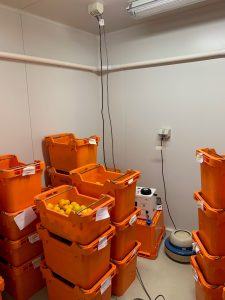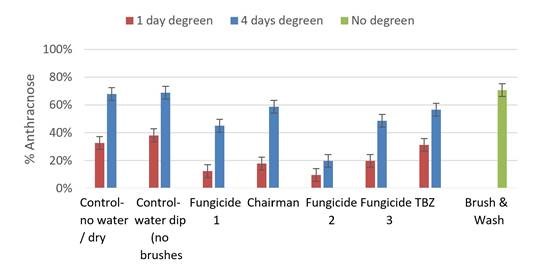26 June 2020
A refresher on postharvest degreening
A refresher on postharvest degreening
26 June 2020
By John Golding, Research Horticulturist, NSW DPI
Degreening is the process of removing the green colour (chlorophyll) from the skin of citrus fruit after harvest using ethylene gas treatment. It is used to meet the market demand for fully orange citrus fruit.
While degreening is a common postharvest practice across Australia at different times of the year, there is a need to revise the best handling and treatment tips.
The most critical aspect associated with degreening is ensuring the fruit meet the Australian Citrus Standard (ACS) for eating quality maturity. Immature dark green fruit will not properly degreen and, more importantly, will not meet the ACS as the fruit will have high acidity and low sugar content.
Ethylene degreening does not ripen the fruit and will not change the levels of sugars and acids. Therefore, when degreening, it is critical to only pick fruit that meet the ACS for harvest maturity based on both eating quality and colour i.e. not just colour.
Degreening success can vary with variety, the initial colour of the fruit, concentration of ethylene used and the duration of ethylene exposure. Whilst many growers and packers have been degreening their fruit for many years, this is a timely reminder of the best practice tips for degreening:
- Fruit should have some colour development and not be totally green
- Fruit should be colour sorted when picking
- Fruit should be internally mature to meet and exceed the ACS
- Harvest fruit carefully as any rind damage will be increased by the degreening process
- Treat fruit with a postharvest fungicide prior to degreening
- Good air circulation in the degreening room is important to ensure the air moves through the fruit load, not around it
- It is important to have an efficient ventilation system is critical to extract the carbon dioxide (CO2) generated by the fruit during degreening
- Do not wax fruit prior to degreening as this will inhibit full colour development
- Fruit treated with a late gibberellic acid (GA) spray will take longer to degreen or may not fully colour
- Fruit treated with an oil spray shortly before harvest (within 2–4 weeks) may not achieve full colour
- High ethylene concentrations cause the fruit calyx (button) to dry out and turn brown. Fruit can be dipped in the synthetic auxin 2,4-D to help keep buttons green, but 2,4-D can also delay the degreening process
Postharvest storage trials in the previous Hort Innovation Citrus Postharvest Project (2019) highlighted the amount of time in degreening had a significant impact on anthracnose incidence (‘gas burn’) in Imperial mandarins (Image 1).
Fruit that had degreened for one day had 23% anthracnose infection, while fruit treated for four days had 52% infection. Prolonged exposure to the high temperatures and humidity necessary for degreening, drive anthracnose damage (‘gas burn’) in the skin.
Therefore, shorter degreening treatment times are recommended. In order to achieve shorter degreening times, it is recommended to harvest fruit at a less green stage.
As part of the same postharvest research study different postharvest dip treatments were tested to Imperial mandarins from Queensland aimed at minimizing the expression of the anthracnose (‘gas burn’) (Image 2).
Results showed that some of the standard current postharvest fungicides for control of green and blue mould could also reduce anthracnose damage. For example, the postharvest fungicides ‘ChairmanTM’ (fludioxonil and propiconazole) and thiabendazole reduced the number of fruit with anthracnose symptoms (see Graph).
Other postharvest fungicides registered for other horticultural crops, but not citrus, were also trialed. Some of these fungicides showed good activity against anthracnose and more work will be continuing with these potential alternative treatments.
More information on degreening practices and conditions are available in previous editions of the Australian Citrus News (Autumn and Winter 2017) and the Packer Newsletter.
This is a contribution from the Citrus Postharvest Program (CT19003) funded by Horticulture Innovation and NSW Department of Primary Industries. Levies from Australian citrus growers are managed by Horticulture Innovation and contributed to funding this project. The Australian Government provides matched funding for all Horticulture Innovation’s research and development activities.

Image 1: Severe anthracnose symptoms on Imperial mandarin fruit following degreening and storage


Image 2: Degreening in experimental conditions (top image) and assessing anthracnose symptoms on Imperial mandarins at NSW Department of Primary Industries

Graph: Percentage of Imperial mandarins with anthracnose symptoms following 4 weeks storage at 20 oC. Bars are standard errors around the mean (n=4).
Membership
You are not logged in
If you are not already a member, please show your support and join Citrus Australia today. Collectively we can make big things happen.
